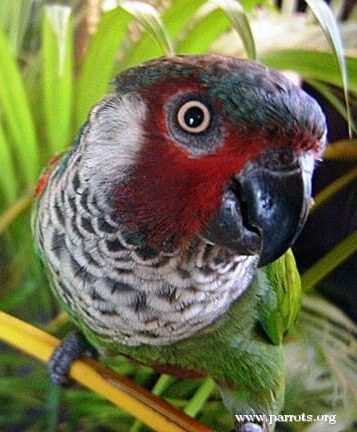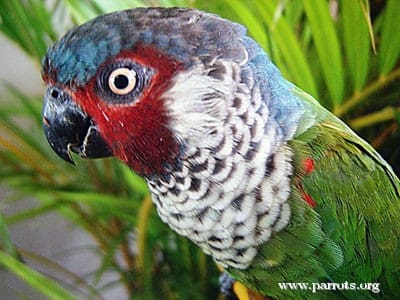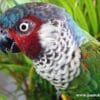Perijá Conure
Also known as:
Perijá Parakeet, Todd's Conure or Parakeet
Also known as:
Perijá Parakeet, Todd's Conure or Parakeet

Pyrrhura

caeruleiceps
Size:
22 cm (8.6 in)
Weight:
About 50-60 g.
Subspecies including nominate:
two: P. c. caeruliceps, P. c. pantchenkoi
Colour Adult:
P. c. caeruliceps: Both adults mostly green in colour; blue forecrown; brown hindcrown washed with blue; nuchal collar blue; white ear coverts; dusky brown breast with grey/off white scalloping; red bend of wing. Beak grey/black. Eye ring bare and dull grey. Eye brown.
P. c. pantchenkoi: Both adults crown grey-brown. to nape with blue wash on forecrown; red becomes brownish on upper cheek; off-white ear coverts; dusky brown upper breast scalloped with off-white; green/brown lower breast, scalloped with yellow/white; thin blue collar on hindneck; red bend of wing; brown/red patch on centre of abdomen; red/brown tail becoming green toward base. Beak dark brown/grey. Eye brown.
Colour Juvenile:
Not recorded.
Call:
A kiir-kiir call while perched and ki-ki-ki-ki associated with alert behaviour.
More Information:
Content Sources:
BirdLife International
Cornell Lab of Ornithology/Birds of the World
Parrots: A Guide to Parrots of the World, Juniper and Parr, 1998
Parrots of the World, Forshaw and Cooper, 1989. 2010 edition
Vanished and Vanishing Parrots, Forshaw, 2017.
Parrots of the World, Forshaw, 2006.
Parrots in Aviculture, Low, 1992.
Lexicon of Parrots, Thomas Arndt.
Captive Status:
Not seen in aviculture.
Longevity:
Probably about 12-15 yrs.
Housing:
Walk-in enclosure or suspended aviary, minimum length 2 m (6.5 ft).
Diet:
Fruits such as: apple, pear, banana, orange, cactus fruits, pomegranate, mangoes, papayas, forming about 30 percent of the diet; vegetables such as: carrots, celery, green beans and peas in the pod; fresh corn; green leaves such as: Swiss chard, lettuce, kale, sowthistle, dandelion, chickweed; spray millet; seed mix such as: canary, millet and smaller amounts of oats, buckwheat, safflower and a little hemp; limited soaked and sprouted sunflower seed; cooked beans or pulses, boiled maize and complete kibble.
Enrichment:
Presumably similar to P. picta: Avid chewers so provide plenty of bird-safe, unsprayed flowering, fir, pine, willow, elder and saskatoon branches, wooden block or vegetable tanned leather toys, heat sterilized pine cones; swings, ropes and ladders; foraging/puzzle toys. Also enjoys bathing so provide overhead misters or shallow water bowls.
Nest Box Size:
Vertical nestbox 20 cm x 20 cm x 70 cm (8 x 8 x 28 in).
Clutch Size:
5-7
Fledging Age:
40-51 days
Hatch Weight:
—
Peak Weight:
—
Weaning Weight:
—
World Population:
1000-2499 mature individuals, decreasing.
IUCN Red List Status:
Endangered
CITES Listing:
Appendix II
Threat Summary:
Habitat loss is the greatest threat to the species, with an estimated 70% having been lost to cattle ranching and other clearance. Habitat destruction in the Sierra de Perijá has also been driven by illicit drug trade and associated enforcement operations. The species is unwilling to cross open habitats, leaving it at risk from forest fragmentation as well. Has also been recorded in the wild bird trade.
Range:
P. c. caeruliceps: Sierra de Perijá, on Colombia-Venezuela border, and N Colombia.
P. c. pantchenkoi: Perijá Mountains, Venezuela-Colombia border.
Habitat:
Found from 450-2000 m (1476-6560 ft) in cloud-forest, both primary and secondary.
Wild Diet:
Food items recorded include guava Psidium guajava, catkins Cecropia peltata, Inga flowers, Alchornea fruits, and fruits from Ficus glabrata. Also Trema micrantha, Croton, Hibiscus, Anthoxylum rhoifolium and Ochroma fruits were also noted.
Ecology and Behaviour:
Usually seen in groups of 3 to 10 birds; less often in pairs. Some flocks are up to 35 birds. Sedentary in afternoon.
Clutch and Egg Size:
5-7 elliptical eggs, 26.5 x 19.0 mm (1 x 0.7 in).
Breeding Season:
Breeding behaviour seen March-August.



